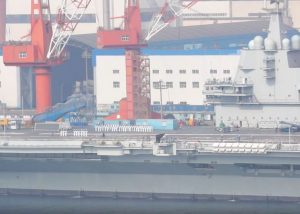The Chinese People’s Liberation Army Navy’s (PLAN) first domestically designed and built aircraft carrier, the Type 002 Shandong (CV-17), was commissioned on Tuesday at a naval base in Sanya on the southern island of Hainan during a ceremony attended by President Xi Jinping, according to local media reports. Xi inspected an honor guard during the ceremony and met with PLAN personnel aboard the carrier, the Global Times reported on December 17.
The Shandong was launched in April 2017 and began sea trials one year later in April 2018. The carrier conducted a total of nine sea trials. During its last sea trial in November, the Shandong passed through the Taiwan Strait and entered the South China Sea. In comparison, the PLAN’s sole operational aircraft carrier, the 60,000-ton Liaoning, a retrofitted Soviet-era Admiral Kuznetsov-class multirole aircraft carrier, completed 10 sea trials before being commissioned in 2012.
As I wrote previously, the Shandong is based on Soviet Navy carrier designs:
The 65,ooo-ton Type [002] carrier was launched at the DSIC shipyard in April 2017.
The Shandong has been fitted with a so-called ski-jump assisted Short Take-Off But Arrested Recovery (STOBAR) launch system also installed aboard the Liaoning. STOBAR-launched aircraft have a more limited operational range and carry lighter payloads than fighter jets launched from so-called Catapult-Assisted Take-Off But Arrested Recovery (CATOBAR) systems used on U.S. Navy carriers. (STOBAR systems put a lot of strain on the airframe of fighter jets during take-off.)
The [future] Shandong will be able to carry up to 24 Shenyang J-15 multirole fighter jets and a variant of the fourth-generation Sukhoi Su-33 twin-engines air superiority fighter, as well as around ten rotary wing aircraft including Changshe Z-18, Ka-31, or Harbin Z-9 helicopters.
The Shandong will be able to accommodate up to 32 fighter aircraft in total, according to senior PLAN officers.
With today’s commissioning, the PLAN is now operating two aircraft carriers, although it will take the Shandong around a decade to be combat-ready, while the Liaoning primarily serves as a training platform for Chinese naval aviation. It may also take a decade or two for a next-generation carrier-based strike aircraft to be deployed aboard the PLAN’s flattops. Chinese pilots and aviation personnel will also need to gain additional experience in operating aircraft from carriers.
As Steven Stashwick pointed out in these pages, the Shandong will likely be beset by so-called “first-in-class problems,” technical and engineering issues that will only become apparent once the ship will begin conducting operations, which will impact the carrier’s reliability. Stashwick also noted that China’s future carrier force may be limited to four hulls due to the massive costs associated with building these huge flattops.
Additionally, the PLAN will also have to gain further experience operating a carrier strike group (CSG). A future PLAN CSG will most likely be composed of Jiangkai-II-class (Type 054A) frigates, Luyang-III-class (Type 052D) destroyers, Renhai-class Type 055 destroyers, and one to two Yuan-class (Type 039A) or alternatively Song-class (Type 039) submarines in addition to support vessels.
The Shandong will be homeported in Sanya.

































